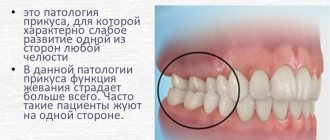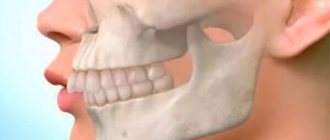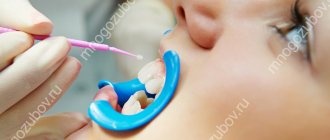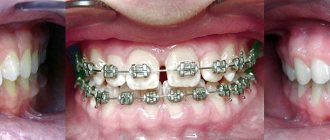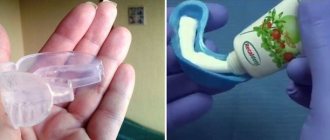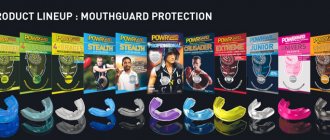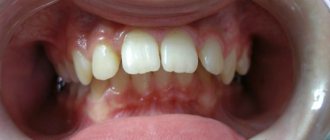Not everyone has straight teeth; almost everyone has, albeit a small, problem with their bite.
It is important to note here that such a deficiency can destroy teeth, create problems with diction and digestion, and also lead to other negative consequences.
Therefore it needs to be corrected. Not everyone likes wearing braces to straighten their teeth; even adults experience some discomfort when wearing them, let alone children.
But there are also mouthguards, this is an alternative method. What is their difference from regular braces and can they correct the bite?
Why are mouth guards needed to straighten teeth and what are they?
Aligners (aligners) appeared not so long ago and are another opportunity to straighten teeth. They were first used in practice 15 years ago. The mouthguards are made in the form of colorless caps; they are made from elastic, but at the same time durable material. They are placed on the teeth, which are aligned due to mechanical action.
It is worth saying that mouth guards are mainly used to solve minor bite problems and to support teeth after using braces. As a rule, bioplastic or biosilicone is used as a material for the manufacture of mouth guards; they are safe for use and non-allergenic.
This is what the mouth guards look like
These materials are quite elastic, but at the same time do not cause injury or scratches to the gums. They are practically invisible on the teeth, which cannot be said about braces. The aligners are transparent and do not attract attention.
It is better to wear aligners constantly; the daily minimum should be 18 hours; they can only be removed when eating or brushing your teeth . Everything here is quite simple; anyone can remove and put on such devices.
As a rule, the doctor issues a set of aligners from two to 30 pieces. When the bite begins to correct, the mouth guard is changed; it is necessary to replace the mouth guard with a new one once every 1.5-3 months.
Types of aligners
There are many different mouth guards that can help straighten teeth. There are different ways to make these devices:
- The individual method involves creating a mouthguard for a specific patient. They are created by a specialist based on a 3D model of the jaw. This option is the most practical.
- Thermoplastic mouthguards are made from a material that can soften in hot water. When the mouthguards are heated, they can be put on, and when they cool down, they take the desired shape.
The material used to make these mouth guards is bioplastic and silicone. They do not cause damage to gums and teeth, are transparent, do not cause allergies, you hardly feel them when wearing them, and they are invisible.
Wearing time
The mouthguards are worn all day. If the bite has a large defect, then the doctor may prescribe mouth guards to be worn all day; they can only be removed when brushing the teeth. There are mouthguards that are worn only at night. Mouthguards are used if the bite has a minor defect, and at the last stage of treatment, to consolidate the effect. Night guards should only be used at night. They are very convenient, but do not have a good effect on large problems.
Mouthguards for children help align teeth correctly. It's easier to straighten children's teeth. To do this, you need to explain to the child the meaning of using mouth guards and constantly wearing them if necessary.
Installing a mouthguard
There are no differences between adult and children's mouth guards, only their size differs. These pads do not cause the child the slightest discomfort when wearing them, his classmates or fellow students will not see them, and they will not be able to become an excuse for inappropriate jokes. In addition, children are quite easy to train to care for them, since they do not require very complex care.
There is no need to restrain your child in choosing what he can eat or drink and what he cannot. For this reason, teeth correction with aligners has become one of the most excellent modern means of correction.
Overlay veneers
Dental veneers for teeth, as for me these are the teeth of the 21st century, can help out in many ways, for example, just even for photos, especially for those who have a beautiful wide smile and all their teeth are visible. There are many bad reviews and disagreements that they do not stick, do not attach, get in the way in the mouth, create discomfort, fall, and are impossible to talk to. But there are also many good reviews that they perfectly hide missing teeth, and hide their damaged or naturally unattractive teeth.
| Type | upper and lower veneers |
| Color | white |
| Ordered | more than 220 times |
| Rating | 4.2 out of 5 |
Link
When are mouth guards recommended for children?
It is recommended to install mouth guards in the following situations:
- in the presence of a diastema - a large gap between the front teeth;
- with crowded teeth;
- in the presence of an expanded or narrowed dental arch;
- when a person cannot use braces due to an allergy to nitinol, a substance used to make mouth guards;
- as a means of support after using braces.
Treatment with caps
First of all, you should come for an examination to an orthodontist. He will examine the child and give recommendations on the possibility and necessity of installing mouth guards, since there are problems that their use cannot solve.
If the doctor talks about the advisability of using mouth guards to correct the bite, then the child will need to make an impression of the teeth using a special material in order to subsequently use it for a 3D model, according to the shape of which the mouth guard is made.
Mouth guard for bite correction
You will need several trays, and they will also need to be changed as the treatment progresses. Each subsequent mouthguard will have some differences from the initial one.
Before installing mouth guards, teeth with caries and gum disease should be treated. It is also better to remineralize the enamel.
Comfortable plates as an alternative to mouth guards
Plates for correcting malocclusion in children are used during the period of jaw growth and can be used from the age of 2 years. They are made from hypoallergenic materials and have an anatomically correct shape. They are often made in multi-colored versions, with images of cartoon characters or the child’s favorite characters.
Before applying the plates, the orthodontist takes an impression of the jaw, determining the complexity of the work. This design has a durable plastic base that follows the contours and shape of the palate and the inner surface of the teeth. If necessary, mechanisms can be built into the plate to expand it in order to form the correct dentition and provide space for growing teeth.
For the child’s convenience, orthodontists use removable and non-removable plates. Depending on the age category of the young client, the duration and extent of treatment, the specialist independently determines the type of device.
The doctors at our dental clinic will help your child get a beautiful smile and correct bite. To sign up for a preliminary consultation and examination with an orthodontist, we recommend leaving a request in the appropriate field on the website.
1+
How long are mouth guards used to straighten teeth?
It all depends on the initial state of things, but, as a rule, wearing aligners takes less time than using braces: from 8 months to 2 years. The mouth guards are very convenient to use. They do not cause any harm to the teeth, unlike braces, they do not harm the gums and oral mucosa. It is very easy to get used to them; as a rule, it takes no more than 20 minutes.
Children who use braces for the first time sometimes experience discomfort and even pain during the first days of wearing this device.
Expected result when using a mouthguard
But this will not last long, since the mouth guards are comfortable from the very first days of use and do not cause discomfort. It often happens that in the first days of using mouth guards it is difficult to talk, although they are almost invisible, but due to their presence the dentition becomes thicker, and it will take a little time to get used to it.
Children's mouth guards for straightening teeth do not harm the enamel and do not change its color.
Aligners are very effective when used for minor tooth defects. An early effect from their constant use is often noted; only a couple of months are required to obtain changes for the better.
Benefits of a mouthguard
A dental mouthguard for children has a number of advantages:
- The design is made of transparent silicone, so it is practically invisible when used.
- It is easy to remove and there is no discomfort during use.
- The removable design allows you to take care of your oral hygiene and the device itself without any difficulty.
- The use of high technology in the manufacture of the device guarantees high quality of the product.
- The materials from which the product is made are safe for health.
- The mouthguard does not cause allergic reactions.
- During its use, the tissues and mucous membranes of the oral cavity are not injured.
- While eating, food does not get stuck between the teeth.
- The mouthguard does not cause discomfort or pain when used by children.
- Diction is not distorted and speech is not disrupted.
- A few days are enough to adapt to the adaptation.
- You can lead an active lifestyle in them.
- Mouth guards can be worn at any age.
- They can perform several functions at once: straighten teeth, correct bite, whiten teeth.
Pros and cons of children's mouth guards
Children's mouthguards for straightening teeth have already gained popularity in the market. ъ
And this is quite natural, because they have many advantages: when wearing them, children do not notice any unpleasant sensations, discomfort, pain, or speech defects.
The material from which the mouthguards are made does not leave scratches on the teeth or damage the oral mucosa.
They do not attract attention, they are visible only at a very close distance, and if you move a couple of steps away, they become completely invisible. This gives them a considerable advantage, which may be important for public people or for those who are especially concerned about the aesthetics of appearance.
Mouthguards do not harm the enamel; caries cannot develop under them. The mouth guards are very easy to use and care for. A child wearing mouth guards does not need to change anything in his life; there are no restrictions on the use of products, dental care or oral hygiene.
Why are mouthguards prescribed for children?
In pediatric dentistry, it is strictly forbidden to treat malocclusion using braces, but there is an alternative in the form of aligners. Mouthguards gently influence the direction of growth of milk units and eliminate possible complications caused by insufficiently thorough chewing of food.
A silicone mouthguard for straightening teeth in children is intended not only to bring the dentition into an aesthetic appearance. The design copes with the correction of occlusal disorders, which can prevent the development of pathologies of the respiratory organs and gastrointestinal tract system.
Important! We do not recommend buying mouthguards for your child at a pharmacy, since only individually made designs can provide proper treatment for pathologies of dental development.
Care of mouth guards
Caring for children's mouth guards is very simple: every day they need to be washed with water and brushed with a toothbrush; the water should not be very hot, since the mouth guards are sensitive to high temperatures and can lose their shape.
It is imperative to clean your mouth guards every day; this is necessary due to the accumulation of microorganisms in them, which can harm your teeth if hygiene is not maintained.
When wearing braces, it is difficult for children to brush their teeth, but when wearing aligners, such problems do not arise, since they just need to be removed before the cleaning procedure, and then put on again.
Cleaning the trays consists of the following:
- remove the trays before eating;
- Rinse the plates in warm water once a day;
- to store devices, use a box into which oxygen must penetrate;
- Do not use chewing gum while wearing a mouth guard;
- Be sure to maintain oral hygiene: brush your teeth twice a day, use floss during snacks.
Mouth guard for bite correction
Taking into account the pathological changes in the oral cavity, the dentist may prescribe mouth guards to correct the bite, which are divided into the following types:
- Standard. They are produced in mass production, due to which they have affordable prices. They are not prescribed to all children, as they are not suitable for certain painful changes.
- Thermoplastic. They are produced for personal use. This is an excellent appearance for specific malocclusion pathologies. Using the devices is quite simple. Simply place them in hot water and then put them on. Due to their special plasticity, they very freely obtain the desired configuration, removing the defect over time. The device is attached to the jaw.
The device is used strictly as prescribed by the doctor, since the child’s jaw has not yet formed well enough, and this type of system will have a very significant influence on it.
- Individual. This is the most expensive type, since the system is made for each patient personally, taking into account all the characteristic features of the dentition. Individual mouth guards for correcting the bite contribute to the absolute reproduction of the dentition. Systems are made from silicone or polyurethane. Silicone ones can be used at night or for several hours a day, and polyurethane ones - up to 22 hours a day. They are thin, unnoticeable and cause virtually no discomfort.
If the doctor has prescribed a child to wear a mouthguard, he must regularly visit the dentist to check the effectiveness of the treatment. In addition, an important condition is to follow absolutely all professional advice.
Alternative designs
Of course, no design can completely replace a mouth guard . But there are alternative options that are used if for some reason it is impossible to use a mouthguard. Most often used:
Braces
With their help, you can correct those serious pathologies that mouth guards cannot do, since in most cases, a mouth guard eliminates only minor aesthetic defects. If the only problem is that one incisor protrudes beyond the other, a mouthguard will help. If the integrity of the entire dentition is compromised, braces will help. In addition, the price of braces is the most affordable compared to the cost of aligners, which must be changed several times during the course of treatment.
Luminaries
They are installed on each incisor if there are curvatures, gaps or crowding of the teeth.
Veneers
They are attached to each tooth separately.
Trainers
This is a removable structure that is placed on the lower jaw. With its help, you can perform high-quality alignment without discomfort or pain.
Aligners
These are colorless trays that are almost invisible. They are used to straighten teeth. They are quite light and do not cause discomfort in the mouth. They can be easily removed independently if desired. Most often, they simply correct all the imperfections that did not go away after using aligners or braces.
If a child is prescribed a mouth guard by a doctor, he should visit the dentist regularly to properly determine the effectiveness of the treatment. It is also important to follow all the specialist’s recommendations.

